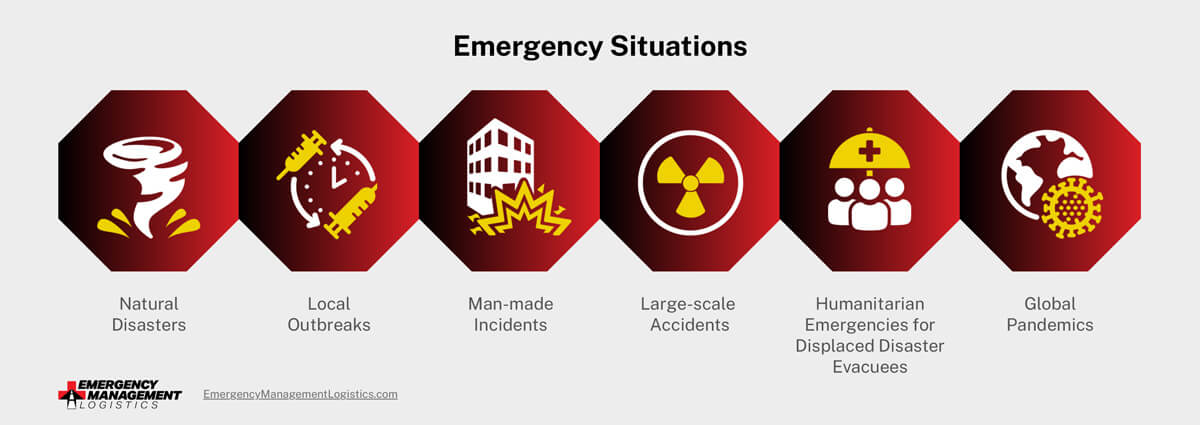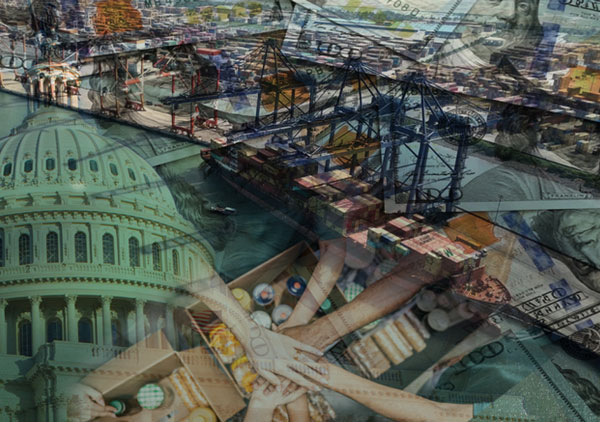



When speed defines survival, time-critical logistics solutions become the backbone of business resilience. Emergencies, whether hurricanes, industrial accidents, or sudden supply chain disruptions, can unfold without warning. In those moments, organizations need more than standard shipping. They need proven rapid response freight delivery that ensures business continuity and recovery.
The stakes are high. Delays can put employees at risk, interrupt access to critical goods, and damage a business’ reputation. That’s why agencies like the Federal Emergency Management Agency (FEMA) and the Occupational Safety and Health Administration (OSHA) emphasize emergency management preparedness, stressing that time is one of the most valuable resources in crisis response.
Companies that partner with experts in expedited shipping and rapid delivery protect not only their supply chains but also their communities and customers.

Threats are broader than most businesses realize. From hurricanes and tornadoes to wildfires, earthquakes, and even sinkholes, the US faces at least 12 major types of natural disasters alone. Add in man-made crises such as chemical spills or terrorist incidents, and the range of potential emergencies becomes staggering.
Each carries unique challenges, but all share one constant: the need for disaster relief logistics that activate without delay. Ahead, let’s examine why rapid response logistics matter, how time-critical and critical shipments differ, and what strategies help businesses recover faster when the unexpected happens.
If your organization isn’t prepared with a proactive emergency plan, trusted experts are here to help. Call (855) 420-9447 now.
Next, let’s look at why time makes all the difference when there’s a disaster.
In a catastrophe, response time determines recovery. Time-critical logistics solutions are designed to minimize disruption, protect people and assets, and accelerate recovery. The faster your organization activates, the more likely it is to safeguard continuity and its reputation.

During a disaster, delays compound quickly. Minutes lost in routing shipments or securing assets can mean hours, or even days, of extended downtime.
According to FEMA, the majority of businesses that cannot resume operations within days of a disaster may never fully recover. For companies reliant on supply chains, even brief interruptions of critical shipments can lead to:
Every moment lost has ripple effects.
The National Oceanic and Atmospheric Administration reports that between 1980 and 2024, the US faced 403 weather and climate disasters that cost at least $1 billion in damages each.
While the long-term average was nine per year, the past five years have surged to 23 annually. This is a sharp reminder that disruptions are no longer rare exceptions. That’s why protecting people and your reputation must be top priorities.
Managing time effectively pre-, during, and post-emergency can help the productivity of each of these areas of your business.
Logistics isn’t only about moving freight; it’s about safeguarding people and resources. OSHA emphasizes preparedness as a vital part of workplace safety, underscoring that timely access to supplies, equipment, and evacuation support can save lives.
For example, during the COVID-19 pandemic, hospitals reported to the U.S. Department of Health and Human Services (HHS) that delays in ventilator and oxygen supply deliveries jeopardized patient survival, highlighting how sheer minutes can make the difference between life and death.
Beyond physical safety, your reputation is also at stake. Customers, partners, and regulators expect swift responsibility. Time-critical logistics solutions demonstrate reliability under pressure, reinforcing confidence in your company.
Time-critical logistics solutions provide more than speed; they offer structured resilience.
By leveraging rapid response freight modes like next flight out (NFO) air, hot shot trucking, and last-mile emergency delivery, businesses reduce the risk of prolonged disruption. Flexible routing, pre-positioned staging, and 24/7 activation capabilities ensure continuity even when traditional networks break down.

Emergencies create complex challenges, beyond the obvious need to move freight quickly. Time-critical logistics cover a range of scenarios that businesses often overlook until it’s too late. By anticipating these needs, companies can better safeguard supply chain continuity and avoid costly disruptions.
When standard carriers are unavailable, businesses must rely on high-performance transport solutions such as NFO air freight, air charter, and hot shot trucking. These modes ensure that critical goods bypass congestion and reach their destination without delay.
In particular, NFO and charter services are essential when infrastructure is compromised or roadways are impassable.
Disasters rarely strike in predictable ways. Flooded highways, closed ports, or restricted airspace can halt traditional shipping routes.
Flexible logistics solutions, such as rerouting through alternate hubs, leveraging cross-docks, or staging goods closer to impacted regions, gives organizations the agility to respond to changing conditions. The ability to pivot in real time is one hallmark of effective emergency preparedness.
In federally declared disaster zones, agencies such as FEMA designate priority lanes and triaged routes for emergency shipments. Businesses that coordinate with these logistics frameworks move faster and avoid regulatory delays.
Working with an emergency management partner who understands FEMA logistics systems and Incident Command protocols ensures compliance while keeping critical goods flowing to where they’re needed most.
Every disaster leaves behind lessons about the role of time-critical logistics for optimal recovery. By examining recent US emergencies, organizations can better understand how speed, coordination, and preparedness impact outcomes.
Reviewing FEMA case studies provides actionable insights into where supply chain resilience often breaks down. FEMA’s after-action reports consistently highlight logistics as a decisive factor in recovery.
The message is clear: businesses that plan ahead with rapid response freight can serve their teams and customers more quickly, as well as rebound faster.
In several recent disasters, including hurricanes, wildfires, and widespread flooding, time-critical logistics solutions played a vital role in delivering relief. NFO air shipments transported medical countermeasures, and hot shot trucking delivered essentials when larger networks were blocked.
Going back to a specific major incident and resolution: on the day Hurricane Sandy hit New York, Sysco’s New Jersey warehouse still dispatched 30,000 cases of food and drinks to New York City hospitals and shelters. The continuity of operations, even while local transportation networks were paralyzed, was a pivotal moment.
Consider large retailers like Walmart. They maintain inventory flow through predictive analytics and pre-storm staging, preparing them to enable rapid restocking whenever needed.
These examples demonstrate how the right emergency freight strategy can cut hours or even days off emergency recovery time.
Preparedness determines how well organizations weather disruption.
Businesses that had pre-staged goods, alternate suppliers, or established logistics partners were able to resume operations far sooner than those that improvised under pressure.
For emergency managers, continuity planners, and private-sector leaders, the lesson is clear: preparation paired with time-critical logistics is the fastest path to recovery.
Not all urgent shipments are the same. While critical logistics refer to shipments that are important to operations, time-critical logistics apply when every second truly counts. Distinguishing between the two helps businesses prioritize resources, plan for emergencies, and avoid costly delays.
Time-critical logistics solutions are needed when delays create immediate risk, such as:
These are shipments where timing determines success or failure, and rapid-response modes like NFO or air charter are essential.
Critical logistics involves shipments that are vital, but not always tied to immediate deadlines. Examples include:
While these shipments matter for efficiency, they don’t carry the same life-or-death urgency that defines time-critical shipping.
With pharmaceutical shipments, for example, they’re among the most time-sensitive of all cargo. Whether it’s vaccines requiring strict cold chain handling or urgent delivery of medical countermeasures, time-critical logistics can quite literally mean the difference between life and death.
Confusing “critical” with “time-critical” can lead to misallocated resources, wasted costs, and longer recovery times. Businesses that clearly define these categories are better equipped to use expedited shipping wisely, protect business continuity, and comply with emergency management frameworks.
Now time-critical logistics can appear costly on paper; for example, air charter or NFO shipments may exceed standard freight rates by a wide margin. However, compare that to the alternative:
The investment in speed is often pennies compared to the losses of inaction.

Organizations can’t predict every disruption, but they can identify conditions where a rapid response supply chain is essential. By recognizing these scenarios in advance, organizations can activate time-critical logistics solutions before delays escalate into full-blown crises.
Sudden spikes in demand create pressure on supply chains. A prime example is flu season, when hospitals and pharmacies need immediate replenishment of vaccines and medical supplies.
Time-critical logistics ensure these goods move quickly, avoiding shortages that put health and business continuity at risk.
Industries with short product lifecycles face unique challenges. Among them are:
A delay of even a few days can mean lost market opportunities or compromised safety. Time-critical logistics provide the agility to move new products, replacement parts, or sensitive shipments before their value declines.
Emergencies like hurricanes often disrupt suppliers, ports, or entire regions. Long replenishment cycles magnify the problem, leaving businesses vulnerable to extended downtime.
By integrating rapid response freight modes like hot shot trucking or NFO air, companies can shorten recovery times and restore operations faster than competitors who rely solely on standard shipping. Of course, the ability to recover quickly depends on the stakeholders behind it.

Time-critical cargo logistics solutions serve a wide range of organizations. Whether preventing production shutdowns, staging relief supplies, or ensuring continuity of operations, these services provide measurable value across industries and sectors.
For manufacturers, distributors, and retailers, downtime is expensive.
Disasters can impact agriculture too. Delays aren’t just inconvenient; they can destroy harvests or endanger livestock. Emergency preparedness can ensure perishable produce reaches markets fresh and that feed or veterinary supplies arrive before herds face losses.
Time-critical logistics helps private companies respond to these challenges without losing notable customer trust or revenue.
Federal, state, and local agencies depend on logistics partners who can move supplies quickly and in compliance with FEMA and Department of Transportation (DOT) standards.
Pre-disaster deliveries such as staging water, food, or medical equipment, require speed, coordination, and accountability. Plus, time-critical logistics can mean rushing transformers, cabling, and fuel supplies to restore power grids. After major storms, rapid delivery of these assets can determine whether communities wait hours or weeks for electricity.
During declared emergencies, government agencies rely on time-critical freight to activate response plans hurriedly.
The Red Cross and other humanitarian non-profit organizations (NPOs) face the dual challenge of speed and scalability.
They must stage supplies in anticipation of disasters, then deliver them rapidly to affected communities.
Time-critical logistics solutions provide the flexibility to move goods across regions and ensure aid reaches people when it matters most.
Whether private or public, as these examples show, time-critical logistics aren’t a luxury; they’re a lifeline.
“If you fail to plan, you are planning to fail.”—Benjamin Franklin
Looking ahead, the rise in climate volatility and global supply chain shocks means that emergencies will only grow more frequent and severe. Organizations that build time-critical logistics into their continuity planning now will be the ones positioned not just to survive the next disruption, but to lead through it.
Remember, disasters strike without warning, but your response doesn’t have to be uncertain.
Time-critical logistics solutions transform time from a liability into your greatest asset. Bridge the gap in business continuity, protecting people, and restoring operations faster than competitors who still rely on standard shipping.
Preparedness is not just about having a plan; it’s about having the right emergency management logistics partner. Whether your organization faces supply chain disruption, medical emergencies, or large-scale natural disasters, rapid response freight ensures you stay resilient in the face of uncertainty.
It’s this supply chain rapid response that separates organizations who recover quickly from those left behind.
Don’t wait until the next disaster hits. Partner with experts who specialize in time-critical logistics solutions.
Call (855) 420-9447 today to strengthen your emergency preparedness and secure continuity.